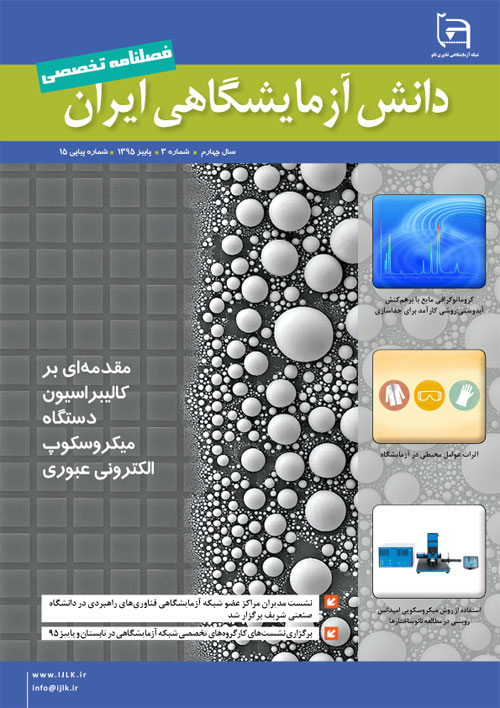فهرست مطالب

مجله دانش آزمایشگاهی ایران
سال چهارم شماره 3 (پیاپی 15، پاییز 1395)
- 38 صفحه،
- تاریخ انتشار: 1395/09/10
- تعداد عناوین: 7
- اخبار
-
صفحه 2
- استاندارد
- مقالات
-
صفحه 14
-
صفحه 31
-
Page 7
Hydrophilic interaction liquid chromatography (HILIC) provides an alternative approach to effectively separate small polar compounds on polar stationary phases. The purpose of this manuscript was to review the options for the characterization of HILIC stationary phases and their applications for separations of polar compounds in complex matrices. The characteristics of the hydrophilic stationary phase may affect and in some cases limit the choices of mobile phase composition, ion strength or buffer pH value available, since mechanisms other than hydrophilic partitioning could potentially occur. Enhancing our understanding of retention behavior in HILIC increases the scope of possible applications of liquid chromatography.
Keywords: Hydrophilic interaction liquid chromatography, Stationary phase, Mobile phase, Separation mechanism -
Page 14
The measurement results do not mean a single concept and they should be standardized and compared. After measuring and comparing with standards necessary measures to control and prevent environmental hazards in the work and impact of these factors on the results will be made. Therefore, the identification of environmental factors in the laboratory is of particular importance. Generally environmental factors in the laboratory are as follows: Physical factors: noise, vibration, lighting, heat, humidity, cold, pressure, radiation. Chemical elements: Chemical materials: solid, liquid, gas and steam, suspended particulate matter (dust, smoke, fog, etc.) Biological factors (biological): viruses, bacteria, parasites, fungi and so on. Ergonomic factors (poor ergonomic conditions): improper body posture while working, physical mismatch between the worker and the work assigned, appropriate tools and so on. Mechanical factors: Any factor in the workplace which caused the accident or injury such as a work tool, sharp edges or works at height. If optimal, recommended conditions and standards for the elimination of harmful factors are not respected in workplace will lead to damaging factors and will certainly affect the accuracy of the results, so the identification and elimination of harmful factors are of importance.
Keywords: environmental factors, laboratory, standards, identification, elimination -
Page 19
Impedance Scanning Microscopy (SIM) is a combination of Scanning Probe Microscopy (SPM) with conductive probe and Impedance Spectroscopy. The SPM probes with nanometer size close to the surface and prepared three-dimensional topographic images with atomic resolution of sample surface. Typically in Scanning Probe Microscopy when require to create a potential difference between sample and probe, a direct current (dc) voltage is used directly to calculate the impedance of the alternating current (ac). Specifically, SIM is a method based on Scanning Probe Microscopy for preparing quantitive images from properties of alternating current.
Keywords: Scanning Probe Microscopy, ConductiveProbe, Impedance Spectroscopy, Atomic Resolution -
Page 27
This article provides an introduction to calibrating transmission electron microscopes (TEM). If at any time microscopists suspect that something has gone wrong TEM results, a few quick measurements with a calibration sample will immediately verify or nullify the suspicions. There are three major calibrations for TEM’s. Magnification calibration (images), Camera constant calibration (diffraction patterns), Image/ diffraction pattern rotation calibration (relationship between the images and diffraction patterns). Instructions for each are represented.
Keywords: Magnification calibration, transmission electron microscope, calibration


